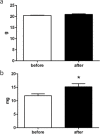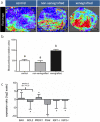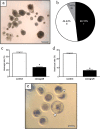Ovarian Grafts 10 Days after Xenotransplantation: Folliculogenesis and Recovery of Viable Oocytes
- PMID: 27362486
- PMCID: PMC4928796
- DOI: 10.1371/journal.pone.0158109
Ovarian Grafts 10 Days after Xenotransplantation: Folliculogenesis and Recovery of Viable Oocytes
Abstract
Ovarian xenotransplantation is a promising alternative to preserve fertility of oncologic patients. However, several functional aspects of this procedure remained to be addressed. The aim of this study was evaluate the feasibility of xenotransplantation as a strategy to maintain bovine ovarian grafts and produce oocytes. Adult ovarian cortical pieces were xenotransplanted to the dorsal subcutaneous of female NOD-SCID mice (n = 62). Grafts were recovered ten days after xenotransplantation. Host and graft weights; folliculogenesis progression; blood perfusion, relative gene expression and number of macrophage and neutrophil of xenografts; in vitro developmental competence of graft-derived oocytes were evaluated. Folliculogenesis was supported in the grafts, as indicated by the presence of primordial, primary, secondary, antral, and atretic follicles. The xenografts showed a greater volumetric density of atretic follicles and higher hyperemia and number of host-derived macrophage and neutrophil (P<0.05), when compared to non-grafted fragments. There was a higher blood perfusion under the back skin in the transplantation sites of host animals than in control and non-grafted (P<0.01). BAX and PRDX1 genes were up-regulated, while BCL2, FSHR, IGF1R and IGF2R were down-regulated, when compared to the control (P<0.01). Twenty seven oocytes were successfully harvested from grafts, and some of these oocytes were able to give rise to blastocysts after in vitro fertilization. However, cleavage and blastocyst rates of xenograft derived oocytes were lower than in control (P<0.01). Despite showing some functional modifications, the ovarian xenografts were able to support folliculogenesis and produce functional oocytes.
Conflict of interest statement
Figures




Similar articles
-
Development of antral follicles in cryopreserved cat ovarian tissue transplanted to immunodeficient mice.Theriogenology. 2004 Jan 15;61(2-3):581-94. doi: 10.1016/s0093-691x(03)00244-9. Theriogenology. 2004. PMID: 14662154
-
Growth and fertilization of porcine fetal oocytes grafted under the renal capsules of nude mice.Theriogenology. 2016 Oct 15;86(7):1740-8. doi: 10.1016/j.theriogenology.2016.05.031. Epub 2016 Jun 2. Theriogenology. 2016. PMID: 27377208
-
Maturation and fertilization of porcine oocytes from primordial follicles by a combination of xenografting and in vitro culture.Biol Reprod. 2003 Nov;69(5):1488-93. doi: 10.1095/biolreprod.103.017038. Epub 2003 Jul 9. Biol Reprod. 2003. PMID: 12855599
-
Xenotransplantation in immunodeficient mice to study ovarian follicular development in domestic animals.Theriogenology. 2010 Apr 1;73(6):740-7. doi: 10.1016/j.theriogenology.2009.10.002. Epub 2009 Nov 12. Theriogenology. 2010. PMID: 19913288 Review.
-
Oocyte growth and acquisition of meiotic competence.Soc Reprod Fertil Suppl. 2007;63:531-8. Soc Reprod Fertil Suppl. 2007. PMID: 17566297 Review.
Cited by
-
Drastic Loss of Antral Follicles Due to Gene Expression Dysregulation Occurs on the First Day After Subcutaneous Ovarian Transplantation.Reprod Sci. 2023 Aug;30(8):2524-2536. doi: 10.1007/s43032-023-01184-1. Epub 2023 Feb 9. Reprod Sci. 2023. PMID: 36759496
-
Hormonal Stimulation of Human Ovarian Xenografts in Mice: Studying Folliculogenesis, Activation, and Oocyte Maturation.Endocrinology. 2020 Dec 1;161(12):bqaa194. doi: 10.1210/endocr/bqaa194. Endocrinology. 2020. PMID: 33099627 Free PMC article. Review.
-
Influence of graft size, histocompatibility,and cryopreservation on reproductive outcome following ovary transplantation in mice.J Assist Reprod Genet. 2019 Dec;36(12):2583-2591. doi: 10.1007/s10815-019-01620-9. Epub 2019 Nov 18. J Assist Reprod Genet. 2019. PMID: 31741257 Free PMC article.
-
Protective effects of resveratrol on random-pattern skin flap survival: an experimental study.Am J Transl Res. 2019 Jan 15;11(1):379-392. eCollection 2019. Am J Transl Res. 2019. PMID: 30787995 Free PMC article.
-
Effects of different subcutaneous sites on heterotopic autotransplantation of canine ovarian tissue.Vet Res Commun. 2023 Dec;47(4):1893-1905. doi: 10.1007/s11259-023-10139-5. Epub 2023 May 18. Vet Res Commun. 2023. PMID: 37198523
References
-
- Dittrich R, Maltaris T, Hoffmann I, Oppelt PG, Beckmann MW, Mueller A. Fertility preservation in cancer patients. Minerva Ginecol. 2010. 62; 63–80. - PubMed
-
- Kim SS, Soules MR, Battaglia DE. Follicular development, ovulation, and corpus luteum formation in cryopreserved human ovarian tissue after xenotransplantation. Fertil Steril. 2002. 78; 77–82. - PubMed
-
- von Schönfeldt V, Chandolia R, Kiesel L, Nieschlag E, Schlatt S, Sonntag B. Advanced follicle development in xenografted prepubertal ovarian tissue: the common marmoset as a nonhuman primate model for ovarian tissue transplantation. Fertil Steril. 2011. 95; 1428–34. 10.1016/j.fertnstert.2010.11.003 - DOI - PubMed
MeSH terms
Substances
LinkOut - more resources
Full Text Sources
Other Literature Sources
Research Materials
Miscellaneous

